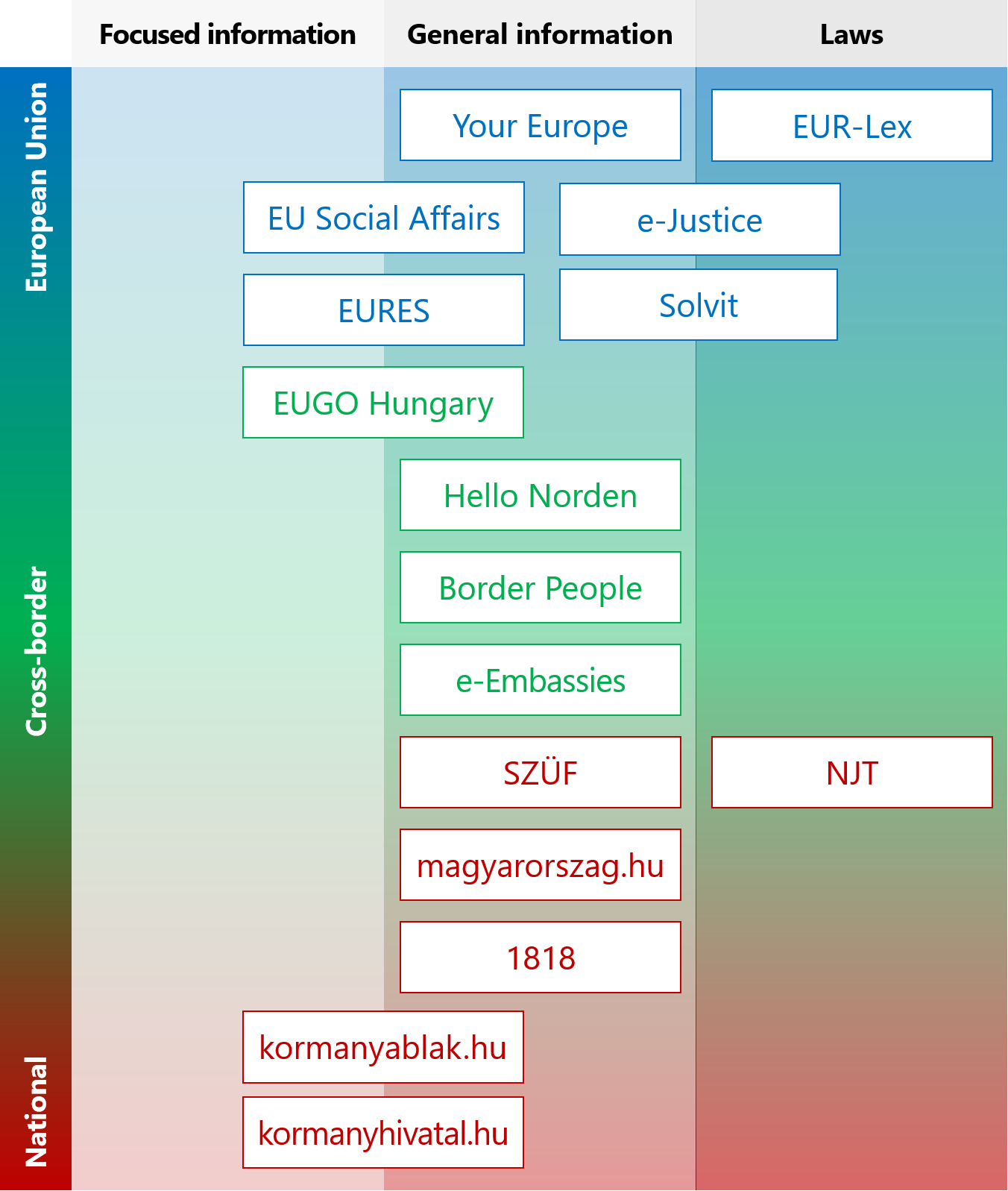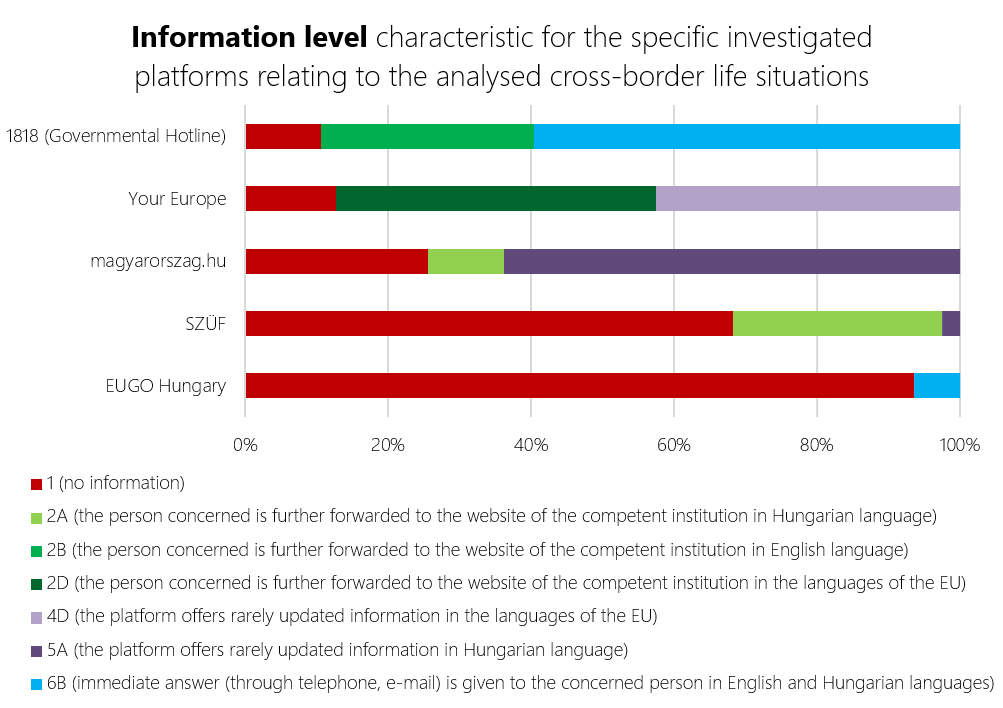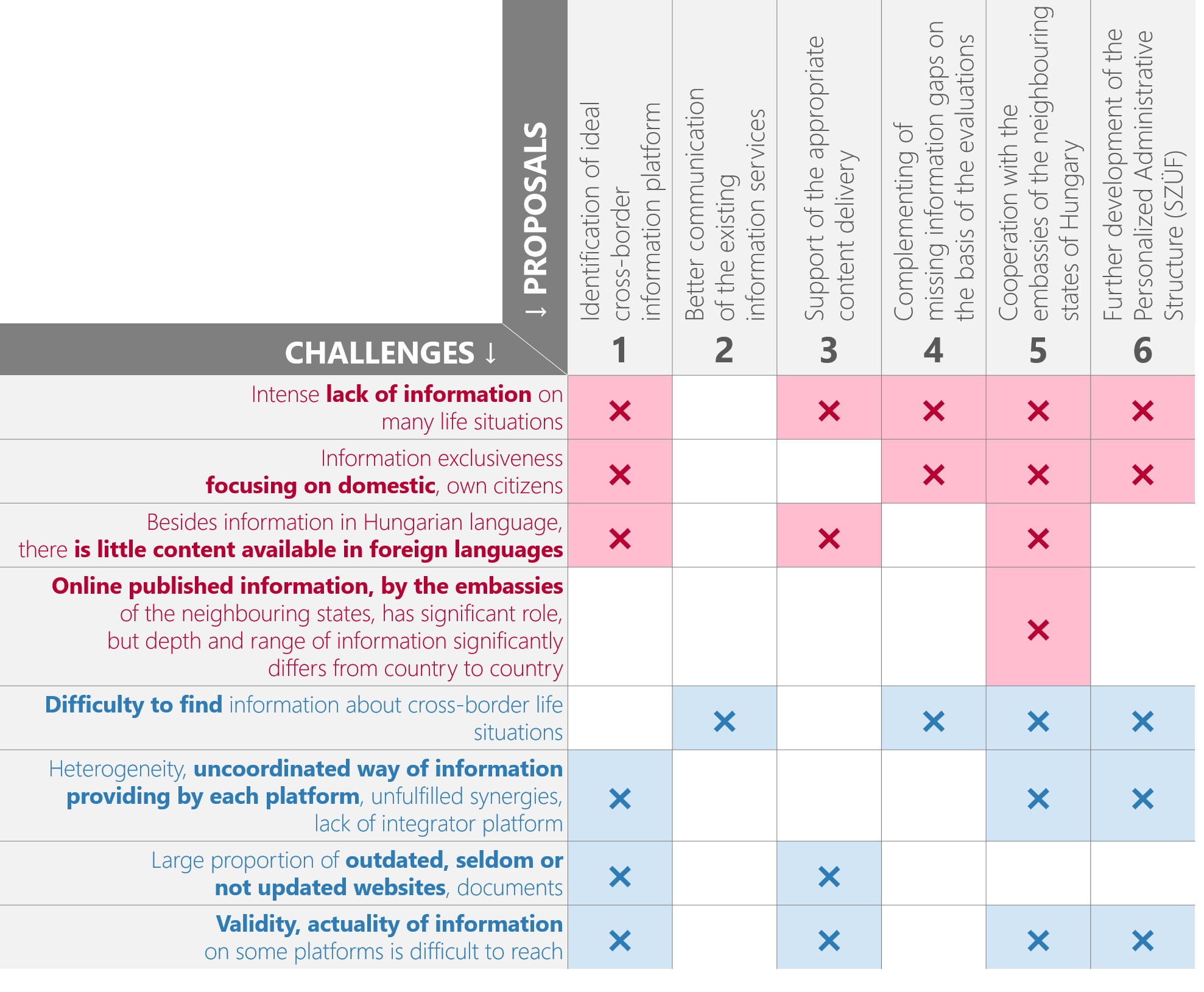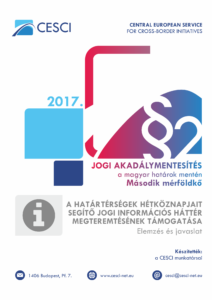The study (Information systems) prepared in the frames of this subproject can be downloaded by clicking on the picture below (in Hungarian).
Results of the subproject were summarized in the following points. Click on the text for details.
Objective of the subproject
One of the main conclusions of the 2016 Legal Accessibility project was that in most cases insufficiency of information generates the biggest obstacle of cooperation for people living in border areas. Therefore, the first horizontal proposal of the project aims to improve information mechanisms.
Within the project in 2017, the objective of the subproject, “supporting the creation of a legal information background in order to help the everyday life of border areas”, was to review, to analyse the electronic information systems that are related to everyday cross-border life situations, and to evaluate the contemporary solutions; to articulate proposal on the basis of identified information in order to terminate the shortage within the domain of information.
The authors wanted to achieve the followings:
- to identify the main formal options of receiving information for the participants in cross-border mobility,
- to see the condition of the information systems on systematic level,
- to identify those life situation, where information gaps are relevant,
- begin to prepare the development of information opportunities for the participants in cross-border mobility.
On the one hand, the subproject fulfilled its objectives, namely it reviewed the main official information opportunities and it articulated development opportunities. At the same time, it became clear that huge number of various official online platforms were established across Europe which mainly, or with multiple purposes, aimed to inform the citizens on various levels. To find and identify these online platforms are mainly depend on fortune (do the citizens find the appropriate platform). Subsequently, this pattern embodies a risk that the prepared study could not fully review the information systems. On the other hand, it significantly complicates the orientation practice for cross-border mobility participants. At the same time, integration of information sources has been already started at the EU level which is expected to establish an integrated digital client service around 2025.
Presentation of the activities that were implemented within the frame of the subproject
The main activity within the frame of the subproject was the compilation of a study. In this study, CESCI staff analysed the Internet appearance of information which related to everyday life situations in the domain of cross-border mobility, and they made suggestions on the basis of the analysis. During the preparation of the study, various research, questionnaire, analysis, evaluation and negotiation activities were implemented.
The main findings and suggestions of the study
The study, which was prepared within the frame of the subproject, can be divided into three major parts.
In the first part, CESCI staff analysed the conditions of internet information. Actuality and relevance of the subproject is justified by the growing tendency of cross-border mobility which has generated new demands for information by the citizens. In many cases, non-locally-based information requirements can be provided by e-information within the context of e-governance. Creation and diffusion of e-governance were substantially supported by the information boom that happened in the past decades and by dramatic change of the sources of information. The study briefly reviews all three topics.

Analysis of the situation continued with an overview of the regulatory environment which included Hungarian strategic documents and legislations, besides the most important European Union strategic documents. It can be claimed on the basis of the analysis of the regulatory environment that the decision-makers clearly aim to create a user-friendly e-governance. The members of the European Union have their own strategies for developing their e-governance practices; although, the EU eGovernment Action Plan 2016-2020 contains common elements. One of these principles is the following, “enabling cross-border mobility with interoperable digital public services”. The study, prepared within the frame of the subproject, reached almost the same result as the findings of the action plan:
“Currently Single Market-related information, advice, problem-solving mechanisms, contact points and procedures do not operate as a whole but are dispersed, incomplete, not sufficiently inter-connected and not consistently user-friendly – both at EU and national level. It is therefore difficult for users to find the right information and assistance required.” [EU eGovernment Action Plan 2016-2020]
The study continued with the review of existing evaluation systems. The review starts from the conclusion that the rise of the e-governance systems went hand in hand with the self-evident need to quantify, as well as to prioritize the results. After a brief methodological introduction, four international benchmark methodologies were reviewed, with special reference to the results of Hungary. The following conclusions can be deduced for Hungary from the summary of the benchmark results:
- Hungary performs poorly in the domain of e-democracy;
- in contrast, the government outstandingly performs well in handling and resolving cross-border issues;
- cross-border information supply in Hungary is somewhat below the EU average, nevertheless, in comparison with the neighbouring countries – excepting Austria – our lagging is not serious in spite of our linguistic isolation; however, there could be and should be improvement in many ways in this area;
- in the process of creating Single Digital Gateway, lag of Hungary is not significant in comparison with the EU average; although, the situation in the sphere of information services that directly help cross-border cooperation (the aspect for which the present study was also prepared) is far worse than in the case of the neighbouring Union countries and occasionally in non-EU countries.
After investigating the regulatory environment, the existing information systems were analysed. Altogether, we analysed 16 information platforms within the study. The narrowly-focused sectoral portals were not subjects of our study. At the same time, the study deals with the official online law directory of the European Union and Hungary. Besides the European Union and domestic platforms, we also reviewed those pages that specifically aim to inform the participants who are involved within cross-border mobility, and they can be only partly identified as EU or national initiatives.

In the second part, based on the experience that was gained during the tasks of the first part, the authors evaluated the existing electronic information systems by two methods. It was common in the two evaluations that both of the methods approached the quality of information from the life situations that are relevant to cross-border mobility. The first (external) evaluation applied the so called mystery shopping. The second (internal) evaluation involved staff of the Ministry of Interior and it surveyed the official Hungarian platforms of general information. Implementation of the internal evaluation, next to the external one, was considered as important by the authors. On the basis of the learned lessons, the authors thought if the information seeker cannot find any information, it does not automatically mean that information is not formally included within the information system. Joint use of both evaluation methods allowed us to explore the language availability of specific life situation and information.
The external method of mystery shopping provides an overview about a citizen of a neighbouring country, whether he wants to engage in certain life situations in Hungary (e.g. participate in the education process, renting a flat), and the level and depth of electronic information that is available about a particular life situation in his own language. The external evaluation was implemented in the following steps:
- Task of external evaluation started by the development of the mystery shopping method. Within this frame, life situations were identified on the basis of the relating literature, on the other hand life situations were identified on the basis of the experiences of the first legal accessibility project. Steps of the mystery shopping were laid down in this phase.
- Identification of circles of mystery shopping, contacting the mystery buyers. Basis of the methodology was to search the Hungarian content from abroad. That means searches were implemented in the official language of the neighbouring countries (e.g. in Romanian or in Slovak language), as well as in the foreign language that is the most spoken and used in the region, namely in English language. Thus, implementation of the mystery shopping needed users, who use the given languages as native speakers.
- Implementation of the mystery shopping composed of the following nine linguistic domains:
- raw translation of specific life situations into the language of the search,
- entering the raw search phrase(s) into Google[1], running the search,
- clarification of search phrase(s) in case of need,
- the qualitative assessment of the “strongest” result relating to the particular life situation, whereby the following values can be given according to the page, where the relevant information on the life situation can be found in the search language:
- A = official Hungarian site
- B = official site of another country
- C = official EU site
- D = nonofficial site
- Z = the search did not resulted in any meaningful finding
- Summarization and evaluation of the results of the mystery shopping.
The main findings of the external mystery shopping were the following ones:
- based on the lessons learned from the mystery shopping, it can be expressed that most of the official information on individual life situations is available in Hungarian language;
- through internet search, official Hungarian information in English language can be found for half of the analysed life situations;
- information on official Hungarian sites in the languages of the neighbouring countries is very limited;
- on the basis of experience, the role of official information platforms is also significant in the neighbouring countries, information published by the embassies in some cases;
- in case of the EU Member States, the various EU official information platforms have important complementary role;
- there is no relevant information for third of the identified life situations in Slovenian, in Slovakian and in Romanian language, and for a quarter of life situations in Serbian language.

The internal evaluation, implemented by the operators[2], gives information about official Hungarian information platform, namely what kind of information, relating to specific life situations, can be found and language availability of information. The internal evaluation was carried out in the following steps:
- The internal evaluation started with the development of the methodology. Within the frame of this development, those life situations were identified that should be examined. On the one hand, life situations were identified on the basis of the relating literature, on the other hand they were identified on the basis of the experiences which were gained during the first legal accessibility project. Criteria of the evaluation were also laid down in this phase.
- Establishing of contacts with professional evaluators. During the consultation with professional evaluators, we decided to carry out the evaluation. CESCI submitted to the experts the preliminary list of platform for which it requested to implement internal evaluation. The list of platform, which became the object of analysis, was slightly modified by the experts.
- Internal evaluation of five platforms (1818 Governmental Hotline, Your Europe, magyarorszag.hu, SZÜF, EUGO Hungary) was implemented through the following steps:
- To identify the feature of available information on the given life situation within a given platform:
- 1: no information
- 2: the person concerned is further forwarded to the website of the competent institution
- 3: the person concerned is further forwarded to the administrator of the competent institution
- 4: the platform offers rarely updated information
- 5: the platform offers a regularly updated information
- 6: immediate answer (telephone, e-mail) is given to the interested
- 7: they give feedback to the interested party within the foreseeable time (calling back, email the person concerned).
- To identify the language features of available information on the given life situation within a given platform
- A: in Hungarian language
- B: in English language
- C: in other language
- D: in all the official languages of the European Union
- To identify the feature of available information on the given life situation within a given platform:
- Summary, valuation of the internal evaluation results.
The most important conclusions of the internal evaluation:
- a substantial lack of information can be identified in case of every five life situations; there is little available information in the case of individual life situations within the analysed platforms[3]: rental contract, tuition for public education, nursery and kindergarten fees, purchase of real estate, tolling system, foreign car license, recognition of foreign qualifications received abroad;
- in case of numerous life situation, there is no information in any language on any level: purchase of real estate, tolling system, foreign license of car, recognition of professional qualifications received abroad, voluntary activity required for graduation in Hungary, rental contract, tuition for public education, kindergarten and nursery fees;
- English information about life situation is only a few;
- multilingualism is represented with low volume, content is mainly available only in Hungarian language; a substantive exception is represented by the 1818 Governmental Hotline and Your Europe;
- information levels that are provided by each platform are heterogeneous, uncoordinated;
- information content and information roles are split between various portals.

In the third part, the authors made proposals within the following themes with the aim to overcome the lack of information (detailed description of the proposals see in the “Summary of subproject results”):
- definition of the ideal cross-border information platform,
- better communication of the existing information services,
- support of the appropriate content,
- filling the information gaps that were identified on the basis of evaluations,
- cooperation with the embassies of the neighbouring countries,
- developing of a Personalized Administrative Structure.
[1] In 2017, market share of Google Search exceeded 90% in Europe. Source: http://gs.statcounter.com/search-engine-market-share/all/europe/2016
[2] The possibility of internal evaluation was identified by a consultation with the competent employees of the Deputy Secretary of State for Informatics of the Ministry of Interior, as well as with the employees of the National Infocommunications Service Company.
[3] According to the external evaluation, official information regarding toll system is also available in more languages on other platforms.
Summary of the subproject results
The most important result of the subproject was that it empirically revealed that what kind of online information gaps make difficulties in the domain of informing those participants who are involved within cross-border mobility around Hungary. The most serious obstacles, challenges were identified on the basis of evaluation and potential answers and proposals were identified, too. The relationship between the revealed challenges and proposals is summarized in the following figure by the authors:

The first group of challenges (marked with claret colour) requires the improvement, strengthening and development of content in different ways. Challenges grouped within the second groups (marked with blue colour) require methodological and practical development. It can be seen from the figure that each proposal can handle multiple challenges at one time, and solution of an obstacle can be brought by different proposals.
For example, proposals may contribute to the solution of the challenge related to major information shortage in the following ways:
- Identification of an ideal cross-border information platform: within the frame of the proposals, those life situations were identified which have relevant role from the viewpoint of cross-border mobility and which need development of information content.
- Better communication of the existing information services: this proposal has only an indirect effect in resolving this obstacle. The main question of the challenge is whether the user can find available information or not.
- Support of the appropriate content delivery: compilation of the necessary information material for life situations, identified under the first proposal, would require support for content provision. One of the main problems of the existing systems is the lack of resources. It is increasingly difficult to imagine the flow of necessary information, regular data and information change within the system without the needed dedicated staff.
- Complementing of missing information gaps on the basis of the evaluations: information materials are already available for some life situations that were identified within the frame of the first proposal. However, there is still large number of life situations without official information (or they are not available). Starting the improvement of the information material is recommended by these life situations.
- Cooperation with the embassies of the neighbouring states of Hungary: within the frame of the third proposal, there is a need to support the compilation of information materials and regular actualization of information relating to life situations, which were identified within the frame of the first proposal, by different resources. Within the framework of this fifth point, linguistic versions of the information materials could be prepared in cooperation with the embassies of the neighbouring countries. In addition, content could be easily accessible to the citizens of the neighbouring countries.
- Development of the Personalized Administrative Structure (SZÜF): the general structure of the planned content of the e-administration structure, which is expected to be launched in 2018, would be worth to complement that given information concern what kind of citizens and that information for the non-Hungarian citizens is available on which platforms. Contents of the 1st, 3rd and 5th point would be useful to integrate into the page, too.
As it is visible, individual proposals are useful on their own; however, their best influence can be achieved and expressed through their synergy. Similar logical chains can be formulated in the domains of other challenges, too.
Fulfilment of the identified indicators of the subproject
|
Name of the indicator |
Required |
Fulfilled |
| Analysis and proposal relating to internet appearance of legal information in the domain of different life situations |
1 analysis and proposal |
1 analysis and proposal |
Possibilities for continuing the subproject
On the basis of the articulated proposals and the identified difficulties, the following continuation option is conceivable.
1) To conduct a similar internal assessment which was carried out in the domain of general information platforms in the framework of the project, for the sectoral information / administration websites.
2) To launch a marketing campaign in order to familiarize the existing information systems.
3) To establish a working group for supporting appropriate information content.
4) To initiate cooperation in order to create joint information solutions with the embassies of the neighbouring states.
5) Putting together concrete proposals for the planned content with minimum completion of the new e-administration structure, which is expected to be launched in 2018.
